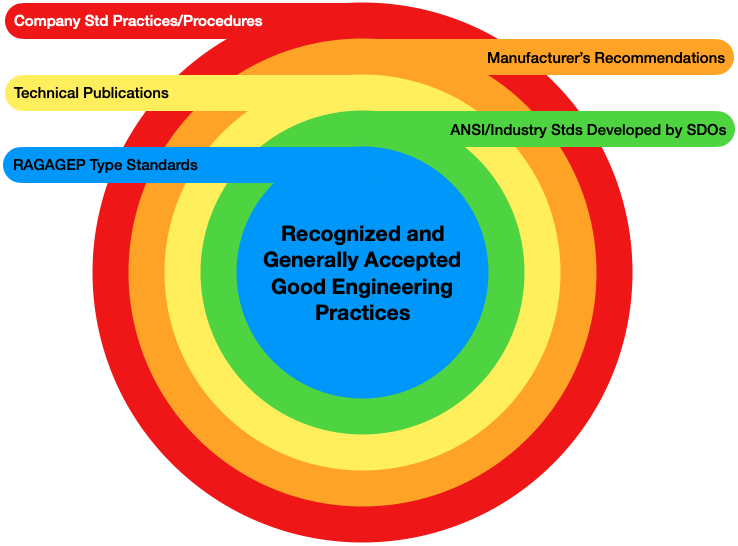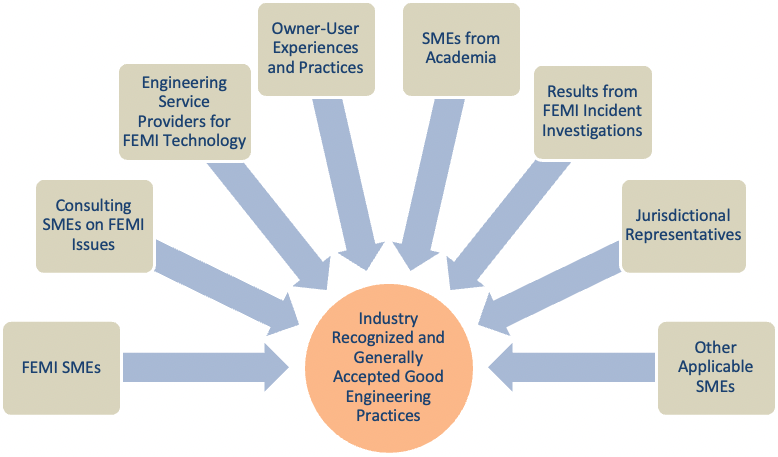Introduction
Do you ever wonder what makes up a fixed equipment mechanical integrity (FEMI) Recognized and Generally Accepted Good Engineering Practice (RAGAGEP) and where it comes from? I’ve heard many different opinions of what does and does not constitute FEMI RAGAGEP, including that of the Occupational Safety and Health Administration (OSHA) [1].
Ask yourself the following questions:
- Do you know how a Good Engineering Practice (GEP) becomes a RAGAGEP?
- Do you know what the various degrees of RAGAGEP are?
- Do you know whether your documented company FEMI practices are considered RAGAGEP?
If any of these questions leave you wondering, read on; I’m going to try to shed some light on these questions in this installment of Reynolds Wrap Up based on my own FEMI experience and perspective over the last 30 years since the OSHA process safety management (PSM) rule (OSHA 1910.119) was first promulgated. RAGAGEP clearly applies to all kinds of equipment used in industry, but in this article, I’m only going to address RAGAGEP for FEMI used in the hydrocarbon and chemical process industries [2].
Industry Codes and Standards
Figure 1 contains a graphic showing what can be considered FEMI RAGAGEP. The green ring in the image is the most prominent, most recognized contributor of valued RAGAGEP (represented by the center blue circle). The green ring consists of industry standards that are generated by standards development organizations (SDOs) using a recognized and generally accepted consensus-building process for developing industry FEMI codes and standards. The American Petroleum Institute (API), American Society of Mechanical Engineers (ASME), American Society for Testing and Materials (ASTM), American Welding Society (AWS), and Association for Materials Protection and Performance (AMPP) are a few of the more prominent organizations using the American National Standards Institute (ANSI) process for consensus building and publication of FEMI standards for the oil, gas, petroleum, and chemical industries [3].

The application of the ANSI standardization process for these FEMI codes and standards provides assurance to the user that the contents of these documents go through a rigorous, fair, detailed, controlled work process of drafting, revising, balloting, and approval of each new or existing code and standard [4]. This reiterative process usually occurs multiple times before new or revised editions are published. Examples of such RAGAGEP codes and standards include API 510, 570, 653, 579, 580, and 40+ other API standards [3,5]. The ANSI standardization process is tedious and lengthy, but it helps to assure the end user that the contents of each standard are fully vetted before publication and that the contents truly represent RAGAGEP for our industry. New and updated technologies, methodologies, and work practices are constantly being reviewed for inclusion in industry FEMI codes and standards. The user that is still using outdated editions of industry FEMI codes and standards is not getting the full value of the latest information and work practices in each of the various codes and standards [4].
Technical Publications
The documents in the yellow ring in Figure 1 also contribute to RAGAGEP in a much more limited way relative to standards developed by SDOs using an ANSI-like consensus-building process. These technical publications consist of FEMI informative articles, books, research papers, industry journals, technical proceedings of industry conferences, etc., some of which may have been peer-reviewed and accepted for specific FEMI aspects in our industry by industry subject matter experts (SMEs). Typically, such documents are generated and used by SMEs for a FEMI topic of a particular aspect of the oil and chemical industry. Examples may include FEMI publications by industry-specific groups (e.g., The Chlorine Institute, Welding Research Council, AMPP/NACE conferences, ASME PVRC), though most of these documents and publications typically do not get reviewed under a formalized consensus-building process like the ANSI standardization process referenced in the green ring in Figure 1. However, it is documents like those described above that often get brought to consensus-based ANSI-type committees for consideration of having portions of them adopted into existing industry codes and standards. That is how “good engineering practices” (GEP) can become RAGAGEP.
Peer-reviewed FEMI technical documents are typically more credible when there is a structured peer review process (utilizing multiple SME peers) to provide enhanced scrutiny, as opposed to having one person take time out of their busy schedule to review a document or even an entire book. So, the yellow ring in Figure 1 consists of other technical publications in the RAGAGEP process, which are better thought of as inputs to potential RAGAGEP documents, as opposed to being RAGAGEP in and of themselves. OSHA recognizes these types of non-consensus documents as potential RAGAGEP, which in my mind is a stretch unless company internal standards specifically recognize them or require adherence to them.
Manufacturer’s Recommendations
The orange ring in Figure 1 consists of manufacturer’s recommendations. OSHA recognizes manufacturer’s recommendations as a type of non-consensus RAGAGEP, but in my opinion, this is a “buyer beware” type of RAGAGEP. Once again, I personally don’t consider manufacturer’s recommendations to be a type of RAGAGEP unless your internal standards require adherence to them.
In my mind, there are two ends of the spectrum of manufacturer’s recommendations. At the more valuable end of the spectrum, there are credible, peer-reviewed, and widely accepted FEMI manufacturer recommendations currently in use in our industry. One example of a credible FEMI RAGAGEP in the orange ring in Figure 1 is the Tubular Exchanger Manufacturer’s Association (TEMA) standard. The TEMA standard for HX design and construction has been around for many decades and is highly credible and accepted by the industry (HX manufacturers, purchasers, and users).
On the much less valuable end of that spectrum are the manufacturer’s recommendations that primarily serve the interest of the manufacturer and not the owner-user. Examples include things like recommended care, maintenance, and replacements that may not be based on real value or owner ROI. These manufacturers’ recommendations are often for recommending services or replacement purchases that serve the best interests of the manufacturer (i.e., selling fixed equipment and related services) as opposed to the safety and reliability of FEMI equipment for the owner-user. For example, if a manufacturer should recommend that a certain type of fixed equipment be shut down, cleaned, inspected, or serviced once per year, that recommendation may be based solely on the manufacturer’s perceived liability concerns or based on services the manufacturer would like to sell to the owner-user. It’s like the case where some jurisdictions require power boilers to be shut down and inspected on a much too frequent basis without any valid evidence that such inspections serve to enhance power boiler safety. I believe that kind of jurisdictional requirement serves mostly to keep jurisdictional inspectors fully employed. So, as I said, “buyer beware” of some manufacturer’s recommendations, and having OSHA recognize many of them for fixed equipment as RAGAGEP is a real stretch of credibility, although it may be more appropriate for other disciplines like rotating machinery, electrical equipment, instruments, and control systems.
Company/Site Documented Standards and Practices
The outer red ring in Figure 1 consists of standards and practices adopted by the owner-user company or even a single operating site. OSHA considers such internal standards/practices as RAGAGEP, and I agree that these become RAGAGEP for each individual company or site in that they are “recognized and generally accepted” (RAGA) by the individual company or site that adopts them. But such standards/practices are not RAGA beyond the individual company or site that issues them, as the consensus-based RAGAGEP process described in the green ring would not have been applied; therefore, such local standards/practices don’t have any application beyond the company that issues and applies them. The exception to this is when an owner-user has success with their internal practices and brings their internal standards/practices to an ANSI committee and submits them for consideration to be included in a consensus-based standard. That does happen and in fact, helps to increase the quality of RAGAGEP after the entire ANSI standardization process has been implemented and satisfied.
I remember well, back in the early 1990s after the first publication of OSHA 1910.119 (1992), an OSHA inspector tried issuing citations to a company for not following documented practices that the inspector had seen and liked at another company he had previously audited. I haven’t heard of such nonsense lately and surely hope that this is no longer happening. Hence, for those sites that have company standards/practices which cover FEMI issues not yet covered by industry consensus documents, you should be expected to comply with them in the event you are subjected to a jurisdictional audit and should not be surprised by citations being issued if you are not in compliance with your own internal RAGAGEP, i.e. say what you do and do what you say. Often internal company standards will reference industry accepted, ANSI practices/documents.
Laws and Regulations
I’ve heard some people claim that laws, regulations, and rules are also RAGAGEP. While I recognize that we all have to follow applicable laws and regulations with regard to our FEMI programs, I think it’s a real stretch to think of most FEMI regulations as “recognized and generally accepted good engineering practices.” While I have come across some excellent FEMI regulations in places like Alberta, Canada, and The Netherlands, most laws and regulations that I have dealt with in the last 50+ years could hardly be considered “recognized and generally accepted good engineering practices.” Certainly, such rules and regulations may contain requirements that we must comply with, and in most cases, they are not necessarily “good engineering practices” let alone “generally accepted” outside of the jurisdiction that promulgated them. Very few jurisdictions have the necessary experienced FEMI SMEs to put together quality FEMI RAGAGEPs. In fact, in my opinion, one US western jurisdiction that I am aware of, lacks sufficient SMEs to even recognize the latest edition of some codes/standards for which they require compliance, and as such, require operating sites to adhere to outdated editions of the codes/standards that they previously adopted. So, for these reasons, Figure 1 does not include a ring for “Laws and Regulations” as a source of RAGAGEP. The most enlightened jurisdictions rely upon and adopt the latest editions of ANSI-based consensus codes and standards into their FEMI rules and regulations.
Contributors to Consensus Standards/Practices
Figure 2 depicts the type of people (mostly FEMI SMEs) and other sources of information that help to build consensus standards like those promulgated by following the ANSI standardization process. The best consensus-based FEMI standardization committees will have SMEs from applicable sources to help put together FEMI codes and standards, as does (for example) the API Subcommittee on Inspection and Mechanical Integrity (SCIMI), the API Subcommittee on Corrosion and Materials (SCCM) and the ASME Post Construction Committee (PCC). As you can see in Figure 2, those SMEs typically come from:
- Owner-users that implement good quality FEMI standards at their operating sites that go beyond existing RAGAGEP codes and standards
- FEMI engineering service companies that assist owner-users in complying with FEMI standards, often with retired owner-users as consultants
- Independent FEMI consulting SMEs (often retired from owner-users)
- Occasionally representatives from academia and jurisdictions
In accordance with the ANSI standardization process, FEMI RAGAGEP standards are typically updated every 5-7 years by the SMEs referenced above using:
- Results from FEMI incident investigations using root cause analysis
- Owner-user experiences using these RAGAGEP codes/standards
- Owner-user internal standards/practices that cover FEMI issues that go beyond existing more broadly applicable codes and standards
- Various new FEMI technologies and methodologies that are starting to be widely applied in the industry

Summary and Conclusions
For those of you who got this far reading about RAGAGEP in this Reynolds Wrap Up, I hope you have gained a better understanding of:
- The various degrees of FEMI RAGAGEP codes and standards (Figure 1)
- How the ANSI-type consensus building standardization process contributes to RAGAGEP
- How your internal standards and practices may be considered FEMI RAGAGEP
- How various industry FEMI technical publications can contribute to improving FEMI RAGAGEP
- Who and what types of information help to create FEMI RAGAGEP (Figure 2)
Knowing that RAGAGEP is a controversial subject, I invite your feedback on this issue by commenting on this article. You may also be interested in watching a brief video on this subject, OSHA and RAGAGEPs, created by Chad Patschke and published on Inspectioneering.com.
References
- OSHA 1910.119, 2016, “Recognized and Generally Accepted Good Engineering Practices in Process Safety Management Enforcement,” Occupational Safety and Health Administration, US Department of Labor.
- Inspectioneering, “Overview of Recognized and Generally Accepted Good Engineering Practices,” https://inspectioneering.com/tag/ragagep.
- ASME PTB-2-2022, 2022, “Guide to Life Cycle Management of Pressure Equipment Integrity,” American Society of Mechanical Engineers.
- Reynolds, J., 2015, The 101 Essential Elements in a Pressure Equipment Integrity Management Program, Second Edition, Inspectioneering.
- API, 2018, Mechanical Integrity: Fixed Equipment Standards and Recommended Practices, American Petroleum Institute.
















Comments and Discussion
Add a Comment
Please log in or register to participate in comments and discussions.